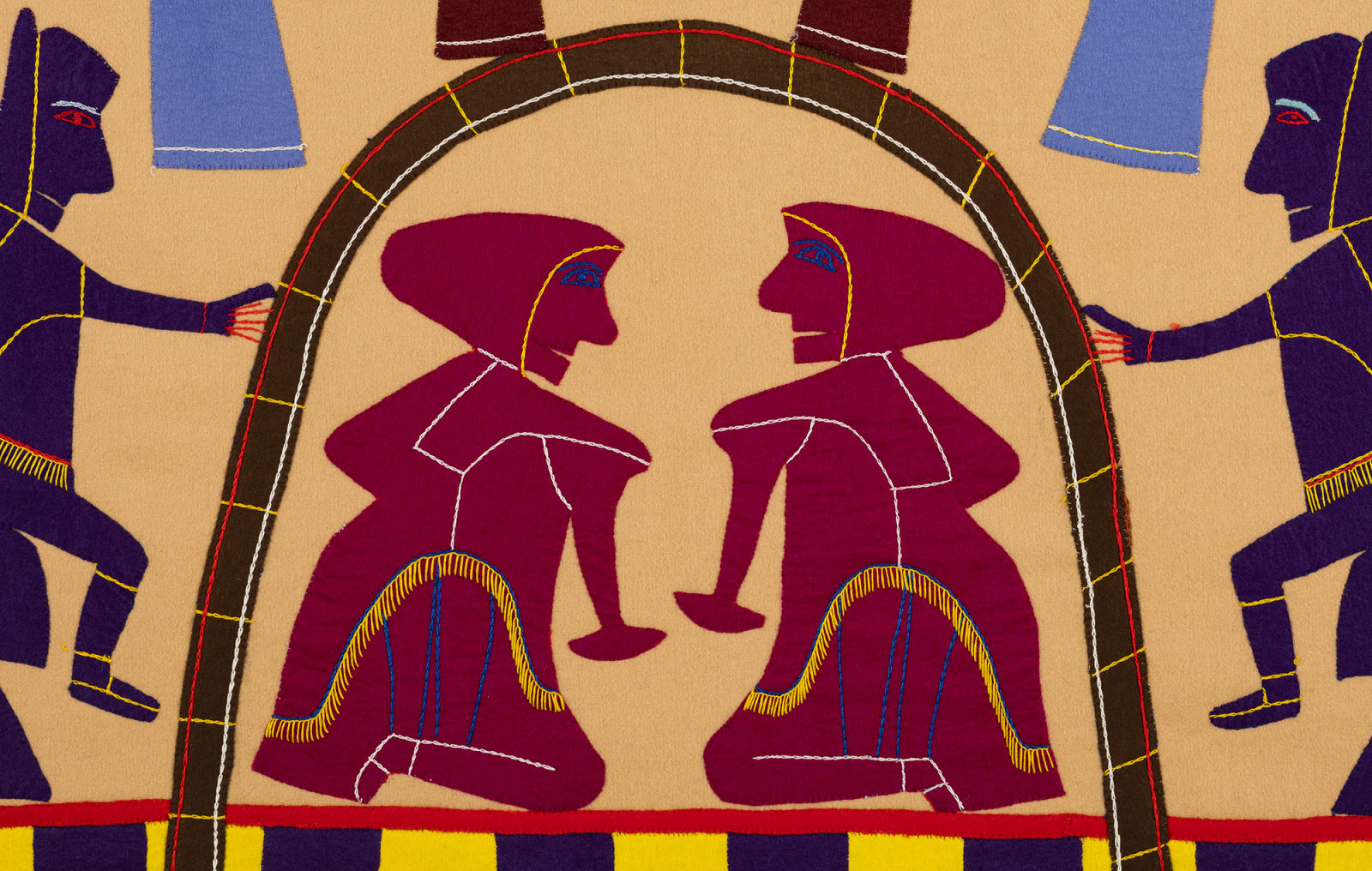-
Artworks
JESSIE OONARK, O.C., R.C.A (1906-1985) QAMANI'TUAQ (BAKER LAKE)
Untitled (Wallhanging), c. 1974-5stroud, felt, and embroidery floss, 61.5 x 47.5 in (156.2 x 120.7 cm)
signed, "ᐅᓇ".
LOT 39
ESTIMATE: $60,000 — $90,000
PRICE REALIZED: $156,000Further images
In her 1994 IAQ article, Bernadette Driscoll-Engelstad describes the imagery in this gorgeous hanging in some detail: “The upper igloo contains two male figures flanking a fish vertebrae, while the...In her 1994 IAQ article, Bernadette Driscoll-Engelstad describes the imagery in this gorgeous hanging in some detail:
“The upper igloo contains two male figures flanking a fish vertebrae, while the lower one encompasses a third igloo enclosing the figures of two kneeling women. The boots drying around the outer edge of the igloo allude to women’s domestic responsibilities. These two juxtaposed images emphasize the separation, yet interdependence, of male and female roles within traditional Inuit culture. Men are aligned with a vertebrae motif – alluding to their role as hunters and to the animal as a source of life – while women preside over the domestic realm, nurturing and caring for the family. Within Oonark’s visual repertoire, the pattern of alternating light and dark diagonals which frame both segments suggest the tudlik or women’s hairsticks. Thus, the entire image is enclosed by the all-embracing force of the female, symbolized by the distinctive tudlik design” [1].
We have a few comments to add regarding the imagery. First, to our eyes, the fish skeleton does double duty as a Christmas tree, with the embroidered circles representing ornaments being placed on it by the male figures. Thus the upper image symbolizes the fusion of traditional and Christian imagery – something not uncommon in Oonark’s work. Second, the alternating yellow and purple blocks of the tudlik design reinforce the snow block shapes of the “actual” small igloo enclosing the female figures, further reinforcing the igloo as a powerful symbol of womanhood. And finally, the three strips connecting the two igloos call to mind the shape of the ulu or woman’s knife.
As compelling as the imagery and symbolism are in this hanging, it is the daring use of colour and pattern that make this work truly remarkable and one of Oonark’s most stunning creations. As Bernadette Driscoll also noted, “Working in cloth offered Oonark the ability to select colours and experiment with combinations of contrasting and neighbouring colour from a range of tones displayed before her. As the colour theorist Josef Albers once noted, such experimentation ‘offers a training no palette can provide.” [2] Here Oonark’s brilliant use of colour extends even to the lovely embroidery stitching along the outer borders. Colour and pattern and design and composition and imagery and symbolism are so unified in this masterpiece that it becomes difficult to discuss them separately. Astonishing and spectacular.
Interestingly, this wall hanging by Oonark is virtually identical in format (double-hung igloo shape) and size to an untitled hanging by the artist illustrated in the 1986 WAG solo exhibition catalogue Jessie Oonark: A Retrospective (cat. 67). However, the theme of the other hanging is rather different, seemingly more “supernatural” than gender-symbolic in its imagery. Another important hanging from the same period presents two large igloo shapes stitched together side by side (see same publication, cat. 66).
1. Bernadette Driscoll-Engelstad (1994), p. 11-12.
2. Bernadette Driscoll (1984), p. 18.
Literature: For the Oonark wall hanging with matching format and size see Jean Blodgett and Marie Bouchard, Jessie Oonark: A Retrospective (Winnipeg Art Gallery, 1986), cat. 67. For another important and visually related large hanging see the same catalogue, cat. 66 (also illustrated in Walker’s Auctions, May 2018, Lot 82). For a drawing with related imagery see the WAG catalogue cat. 70. For other important Oonark hangings see Blodgett and Bouchard, cats. 38, 40, 54, 55, 59, 60; cat. 40 in the WAG catalogue is also illustrated in First Arts, May 2019, Lot 24. See also Ingo Hessel, Inuit Art: An Introduction (D&M, 1998), pp. 170, 176. See also Walker’s Auctions, Ottawa, May 2014, Lot 221, and Nov. 2016, Lot 67.Provenance
Private Collection, Winnipeg.Exhibitions
Northern Lights: Inuit Textile Art from the Canadian Arctic, travelling exh., Baltimore, MD, Baltimore Museum of Art; Guelph, ON, Macdonald Stewart Art Centre, Winnipeg, MB Winnipeg Art Gallery, 1994, cat. no. 17
Publications
Bernadette Driscoll-Engelstad, "A Woman's Vision, A Woman's Voice: Inuit Textile Art from Arctic Canada," Inuit Art Quarterly, Vol. 9, No. 2, Summer 1994, reproduced in colour, fig. 13, p. 11, as "Untitled, Jessie Oonark, c. 1975, Baker Lake (stroud, felt, embroidery thread; 161 .4 x 124.5 cm; private collection);
Katharine W. Fernstrom and Anita E. Jones, Northern Lights: Inuit Textile Art from theCanadian Arctic, (Baltimore Museum of Art, 1994), cat. 17.
Join our mailing list
* denotes required fields
We will process the personal data you have supplied in accordance with our privacy policy (available on request). You can unsubscribe or change your preferences at any time by clicking the link in our emails.












